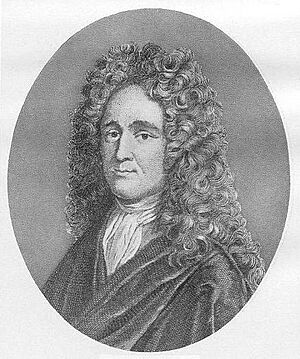André Dacier facts for kids
Quick facts for kids
André Dacier
|
|
|---|---|
 |
|
| Born | 1645 Castres, Languedoc, France
|
| Died | 18 September 1722 (aged 76–77) Paris, France
|
| Nationality | French |
| Occupation | Classical scholar and editor of texts |
| Spouse(s) | Anne Dacier |
André Dacier (born April 6, 1651 – died September 18, 1722) was a French expert in classical studies. He was also a special kind of editor who worked with old texts. He started his career by editing and explaining a very old book called De verborum significatione by Festus. He was the first person to make this 20-book work "readable" for others. His wife, Anne Dacier, was also a very important classical scholar and translator.
Contents
Life and Early Career
André Dacier was born in a town called Castres in France. His father was a Protestant lawyer. He sent André to study at two different schools. First, he went to the Academy of Puy Laurens. Later, he studied at the Academy of Saumur.
Studying with Tanneguy Le Fèvre
At Saumur, André Dacier studied with a famous teacher named Tanneguy Le Fèvre. While studying there, Dacier changed his religion. He became a Catholic and stayed a very religious Catholic for the rest of his life.
When Le Fèvre died in 1672, Dacier moved to Paris. He was chosen to be an editor for a special series of books. These books were called the Delphin Classics.
Marriage to Anne Dacier
In 1683, André Dacier married Anne Lefèvre. She was the daughter of his old teacher, Tanneguy Le Fèvre. Anne became very well known by her married name, Madame Dacier. Many experts agree that her work as a classical scholar was even better than her husband's.
Later Life and Important Roles
In 1695, André Dacier was chosen for two important groups. He became a member of the Academy of Inscriptions. He also joined the Académie française. These were very respected groups for scholars and writers in France.
Soon after, Dacier received a special job. He helped create a history of the king's rule using medals. As a reward for his work, he was made the keeper of the library at the Louvre. The Louvre is a famous palace in Paris. André Dacier died two years after his wife.
André Dacier's Major Works
André Dacier was known for his many important works. He edited and translated several ancient texts. His goal was often to make these old writings clear and useful for students.
Editions and Translations
Some of Dacier's most important works include his editions of Pompeius Festus and Verrius Flaccus. These were ancient Roman writers. He also translated many famous works into French.
His translations included:
- The writings of Horace (with helpful notes).
- Aristotle's book Poetics, which is about plays and poetry.
- Two plays by Sophocles: Electra and Oedipus the King.
- Works by Epictetus, Hippocrates, and Plutarch's Lives.
Working with Anne Dacier
André Dacier and his wife, Anne Dacier, worked together on some projects. They translated Meditations by Marcus Aurelius into French. This was done between 1690 and 1691. They also wrote many notes and explanations for the book.
Editing Festus's Work
When Dacier edited Festus's book, he used ideas from another scholar, Joseph Scaliger. Scaliger had provided notes and extra information. Dacier wanted to create a text that was "clear and educationally useful."
He prepared his work for the Dauphin, who was the prince of France at the time. This is why his editions were often called (in usum Delphini), meaning "for the use of the Dauphin." Dacier was very interested in the real-life details of Roman law and how power worked. He cared more about making the text understandable than its literary style. Dacier's work on Festus was first published in Paris in 1681. It was printed again in 1692, 1699, and 1700.
See also
 In Spanish: André Dacier para niños
In Spanish: André Dacier para niños

